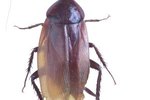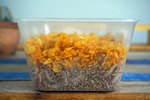
The brown house moth (Hofmannophila pseudospretella) is often considered a secondary clothes moth, as it's not as abundant as many of the other species. It's also sometimes a pantry pest. These small, brown, darkly-marked moths have a voracious appetite for a variety of items found in the home, and therefore may constitute a problem if infestation occurs. Their life cycle and lifespan closely mimic those of other moths.
Life Cycle
Like other moths, brown house moths have a complete metamorphosis that includes egg, larva, pupa and adult. Adults lay eggs -- up to 660 -- on open, rough surfaces near a food source. Upon hatching, the larvae begin to search out food sources which, unfortunately for you, can be seemingly limitless inside a home. Once the larvae have fed, they burrow into their food source and spin silken tubes in which to pupate; they subsequently emerge from their cocoons as adults and begin the cycle again. The life cycle can last 12 months.
Larval Moths
Depending on the environment, eggs may take anywhere between eight and 110 days to hatch into small, white larvae. Like many other house pest moth species, the larval form of the brown house moth is the destructive stage. Like most moths and butterflies, the larval stage of these moths is the feeding stage; caterpillars feed voraciously on anything suitable until they have gained enough nutrition to pupate and become adults. Caterpillars can reach almost 3/4 inch long and are white or creamy white with a tan head. The larval stage can last from between 71 and 145 days.
Adult Moths
Adult moths are rather small, reaching 8 to 15 millimeters long with a wingspan of between just over 1/2 inch and nearly 1 inch. The wings are dark buff to bronze-brown and riddled with black, tan and buff markings. They're most prevalent during the summer and fall months. Adults breed and subsequently lay eggs; there is typically only one generation per year.
Food Sources
The availability of food and other environmental factors plays a role in how long each life stage takes to complete. In most cases, however, there is more than enough food to go around for an emerging infestation. Larvae feed on both organic and inorganic materials. Animal materials such as furs, wool, hides, horsehair and lepidopteran cocoons are all on the menu. In the pantry, these small pests will feed on grains, cereals, seeds, fish meal and more. They will also feed on book bindings and clothing, making it nearly impossible to completely wipe out a food source. Crumbs that fall behind wall baseboards and similar food items often lend to a population boom.
References
Photo Credits
-
Jupiterimages/Photos.com/Getty Images
Writer Bio
With a professional background in gardening, landscapes, pests and natural ecosystems, Jasey Kelly has been sharing her knowledge through writing since 2009 and has served as an expert writer in these fields. Kelly's background also includes childcare, and animal rescue and care.



